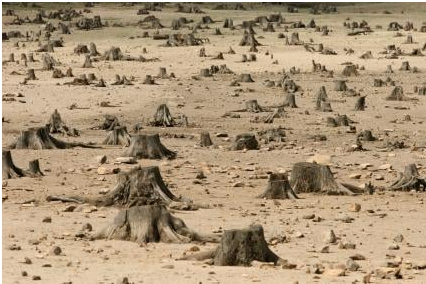Part 2/2
On the initial installment of this article, we talked about the positive impact of deforestation. Today, we will discuss the other side of the coin. And unfortunately, the disadvantages of deforestation far outweigh its benefits. Listed below are some of the negative impacts of Deforestation:
1. Soil is purposely exposed to rain and heat. When forests are being cleared, vegetation which acts as soil cover is removed as well. The bare soil is exposed to extreme scenarios which are produced by the natural rainwater and the heat of the sun. With these natural alternating activities, the soil has a tendency to immediately compact. As rainwater flows through it, nutrients are washed out as well as other organic materials which make the soil fertile and rich. Further, regular cropping, grazing and tilling slowly results in degradation of the soil; making its quality inferior.
These activities are crucial concerns in areas where forest locations are much dry. Agricultural activities on top of deforestation can practically result in the desertification of majority of vast lands. Desertification is also a direct impact of the demand to the soil to product more because of increase in its population, thereby lessening to a serious degree of the lands occupying capacity.
2. Non-suitability of deforested areas for conversion. A lot of the areas that have experienced deforestation are basically not suitable for long-term agricultural activities like farming and ranching. As soon as deprived of its forest cover, the lands immediately degrade in quality, thereby losing their arability and fertility.
The soil in a lot of deforested regions is similarly not suitable for maintaining annual crop products. A lot of the grassy communities are also not as productive as compared to more arable regions and ergo, unfit for cattle grazing and poultry raising.
3. Flooding. Deforestation can bring watersheds that do not have the capacity to regulate and sustain flow of water from streams and rivers. Trees are immensely efficient in the process of absorbing water in volumes, maintaining the amount of watersheds in a normal level. The forest is also regarded as ca cover to prevent seepage and erosion. As soon as they are gone, big amount of water may result into flashfloods, a lot of which caused disasters in parts around the globe.
Once the topsoil which is fertile, is flooded into lower regions, a lot of coral reefs and coastal fisheries suffer sedimentation which is caused by the flooding. This may result in negative effects in the economic viability of several businesses and significant fatalities in the wildlife habitat.
4. The eradication of indigenous communities and their ethnical way of living. When governments decide to undergo deforestation mainly to open its doors for civilized communities, access to forests’ natural resources by ethnical groups are basically taken for granted. To tell you the truth, ethnical groups are often ignored in political and economic decisions that mainly affect their lives. This encroachment makes their rights taken for granted as much as it takes away the natural resources that their forefathers have bestowed on them.
5. The loss of significant amount of biodiversity. This is practically the most serious disadvantage and impact of deforestation. Simply put, it means the extinction and destruction of a lot of animal and plant species, a lot of whom remain unknown and whose benefits will be left undisclosed. Every year, as deforestation continues to emerge, a lot of the wilderness from which we avail of a lot of benefits and would have continued to benefit will forever be eradicated. With it are tons of chances in the form of wildlife that could supply us tons of medical and economic resources to issues we are currently facing.
We cannot deny the fact that deforestation has given us chances to enhance our lives; we have not mastered the perfect kind of responsibility that goes with having control over the earth’s resources. As an outcome, we and thousands of other species on earth suffer immensely from the consequences of our actions.
This article is too short to discuss a lot of issues relative to deforestation. Let us slowly unravel what this has to offer in our future articles.
Source
https://www.nationalgeographic.com/environment/global-warming/deforestation/
https://www.worldwildlife.org/threats/deforestation




